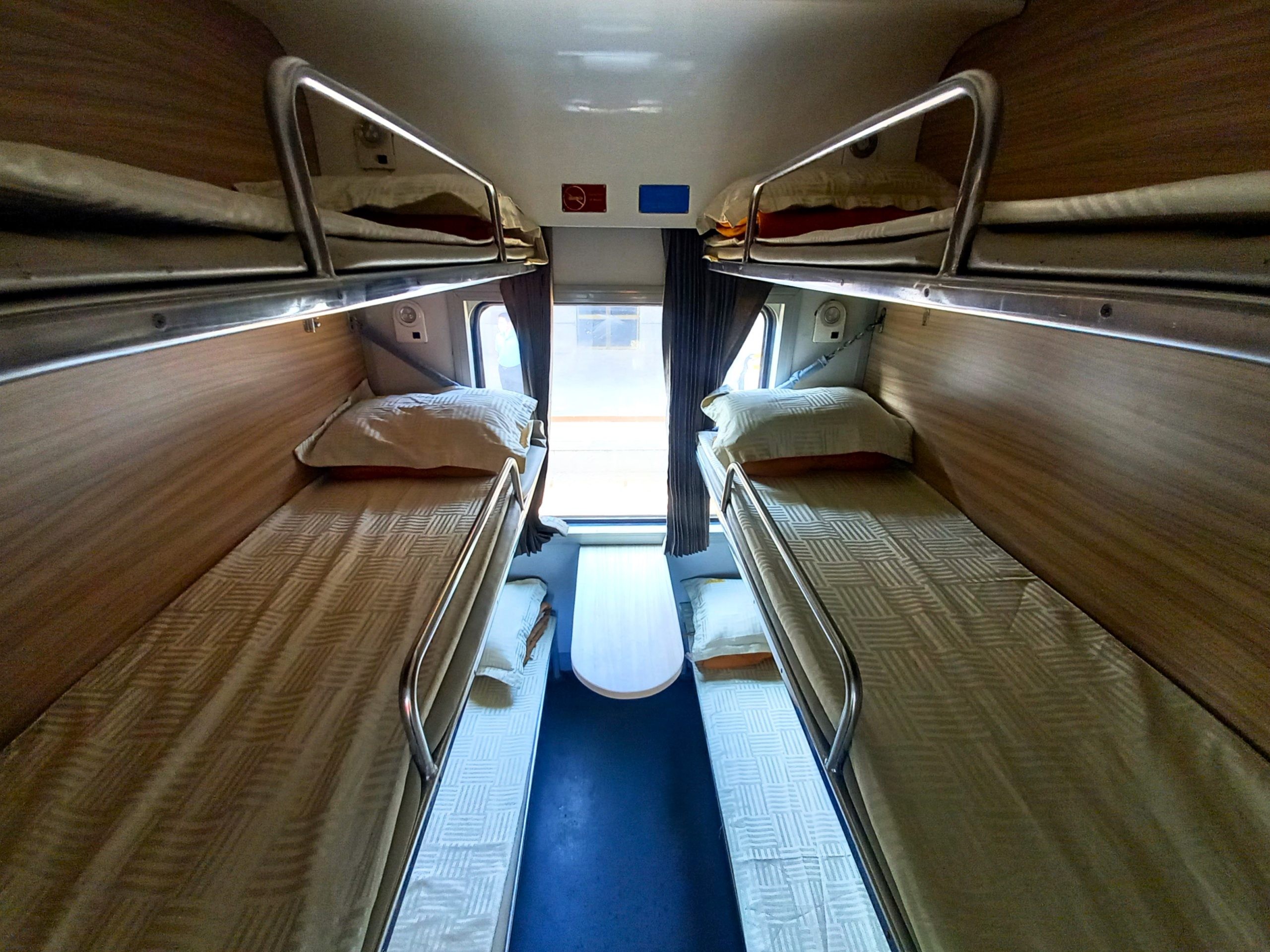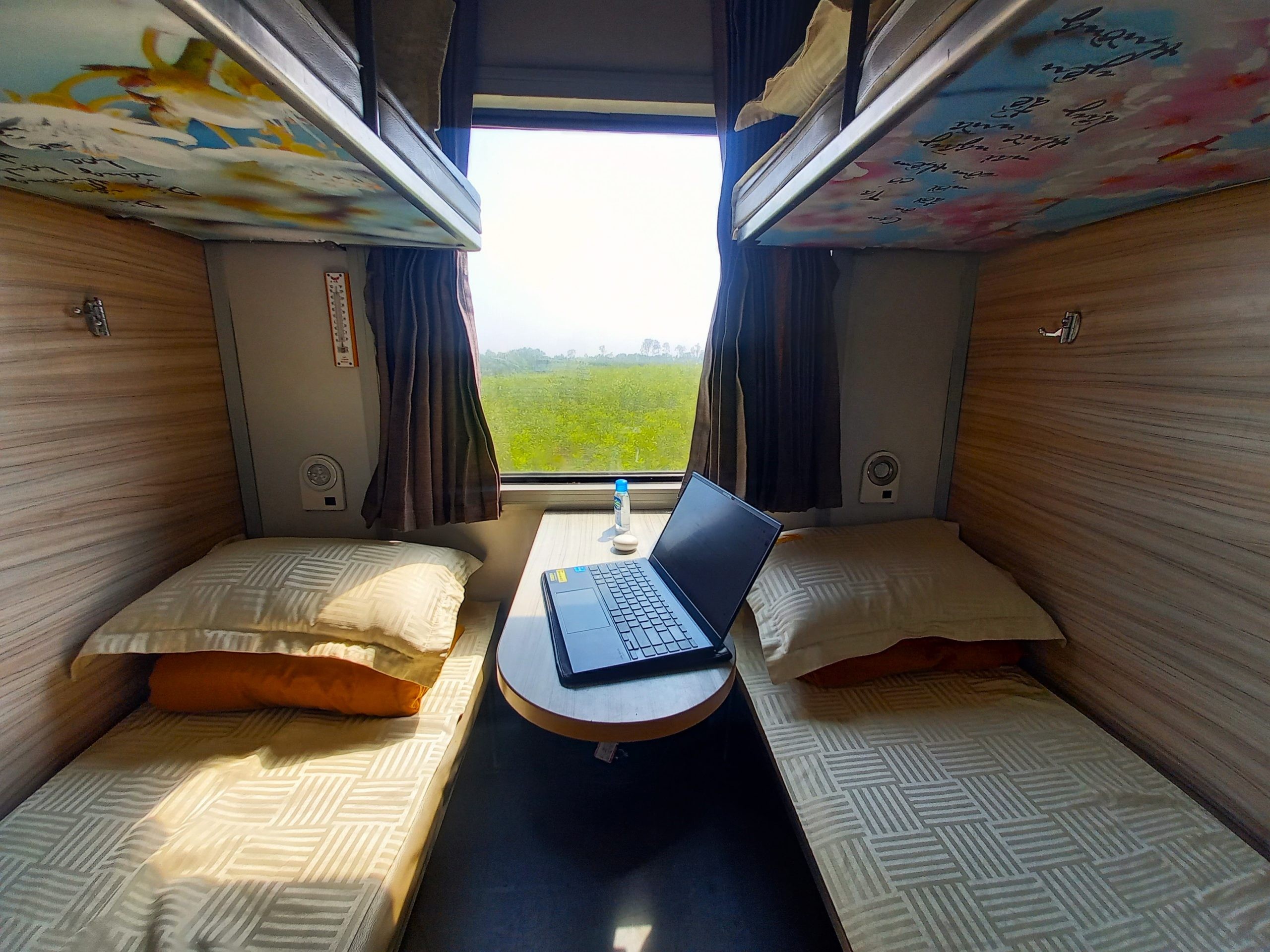Are you curious if you can travel by train in Vietnam? Absolutely! Vietnam offers a unique and rewarding rail travel experience. Forget the sterile experience of flying; train travel in Vietnam allows you to immerse yourself in the country’s diverse landscapes, cultures, and cuisines. Let TRAVELS.EDU.VN be your trusted guide to navigating Vietnam’s railway system, providing seamless booking and insider tips for an unforgettable journey.
1. What Are The Advantages Of Traveling By Train In Vietnam?
Traveling by train in Vietnam offers a unique perspective, allowing you to witness the country’s stunning scenery and cultural diversity. Unlike flying, which isolates you from the land, train travel connects you with the heart of Vietnam. According to a study by the Vietnam National Administration of Tourism, train travel is becoming increasingly popular among tourists seeking authentic experiences, with a 15% increase in rail travel bookings in 2024.
Here’s why train travel is a fantastic option:
- Scenic Views: The railway lines wind through picturesque landscapes, from lush rice paddies to stunning coastlines.
- Cultural Immersion: You’ll pass through bustling towns and rural villages, observing daily life and interacting with locals.
- Comfortable Travel: Choose from a range of seating and sleeping options to suit your budget and preferences.
- Affordable Prices: Train travel is generally more economical than flying, especially for long distances.
- Convenient Booking: Easily book tickets online or at train stations. TRAVELS.EDU.VN offers a streamlined booking process for your convenience.
2. What Are The Main Train Routes And Schedules In Vietnam?
Vietnam’s railway network features a primary North-South line and several branch lines connecting major cities and regions. The most famous route is the Reunification Express (formerly the Transindochinois), running from Ho Chi Minh City (Saigon) to Hanoi, a journey of over 1,700 km. According to Vietnam Railways, at least six trains operate daily in each direction on this route.
Reunification Express Route
- Route: Ho Chi Minh City (Saigon) to Hanoi
- Distance: Over 1,700 km
- Travel Time: More than 32 hours
- Frequency: At least 6 trains daily in each direction
- Key Stops: Nha Trang, Da Nang, Hue, Dong Hoi
Spur Lines
Besides the main line, several spur lines connect Hanoi to other destinations:
- Hanoi to Hai Phong: Perfect for a quick coastal getaway.
- Hanoi to Lao Cai (for Sapa): Popular for trekking and mountain scenery.
- Hanoi to Lang Son: Explore the northern border region.
- Saigon to Phan Thiet: Ideal for beach lovers and kite surfers.
Always check the latest schedules on TRAVELS.EDU.VN, vnr.com.vn, or at major train stations, as they can be irregular, especially in the post-pandemic period. Booking in advance is highly recommended, particularly during holidays and weekends.
3. How Do I Book Train Tickets In Vietnam?
Booking train tickets in Vietnam is now easier than ever. The most convenient way is to use online platforms like TRAVELS.EDU.VN, which offers a seamless booking experience.
Online Booking via TRAVELS.EDU.VN
- Search: Enter your departure and arrival stations and travel date.
- Select: Choose your preferred train time and class.
- Book: Pick your specific carriage, seat, or sleeping berth on the train map.
- Details: Enter your personal information and payment details.
- E-Ticket: Receive an e-ticket with a QR code via email.
Simply show the QR code on your phone to the station staff when boarding. Your ticket will indicate your carriage and seat or bed number.
Other Booking Options
- Train Stations: Purchase tickets in person at any train station, but English proficiency may be limited.
- Vietnam Railways Website (vnr.com.vn): An alternative online option, though not as user-friendly as TRAVELS.EDU.VN.
Advance booking is highly recommended, especially during peak seasons or for popular routes.
4. What Are The Different Classes Of Seating And Sleeping Available On Vietnamese Trains?
Vietnamese trains offer four main classes of travel, each with its own level of comfort and price point. Your choice depends on the duration of your journey and your budget.
Hard Seat
- Description: Wooden seats in a fan-cooled carriage.
- Pros: Cheapest option, informal atmosphere.
- Cons: Can be uncomfortable for long journeys, not air-conditioned.
- Best For: Short trips like Hanoi to Hai Phong.
Alt text: Basic wooden seats in a fan-cooled carriage, the most economical option for short train trips in Vietnam.
Soft Seat
- Description: Reclining, coach-style seats in an air-conditioned carriage.
- Pros: Comfortable, air-conditioned, spacious.
- Cons: Limited sleeping comfort for overnight journeys.
- Best For: Daytime trips like Hue to Da Nang or Saigon to Nha Trang.
Alt text: Comfortable, reclining seats in an air-conditioned carriage, ideal for medium-length daytime train journeys in Vietnam.
6-Bed Sleeper
- Description: Six bunk beds in a private, air-conditioned compartment.
- Pros: Allows you to lie down, potential for social interaction.
- Cons: Can feel cramped, limited space on the top bunk.
- Best For: Shorter overnight trips like Hanoi to Lao Cai.
 6 bed sleeper compartment on Vietnam Railways
6 bed sleeper compartment on Vietnam Railways
Alt text: A six-berth sleeping compartment on a Vietnamese train, offering a budget-friendly option for overnight travel.
4-Bed Sleeper
- Description: Four bunk beds in a private, air-conditioned compartment.
- Pros: Most comfortable option, ample space, power outlets, reading lights.
- Cons: Most expensive class.
- Best For: Long-haul journeys like Saigon to Da Nang or Hanoi to Hue.
 4 bed sleeper compartment on Vietnam Railways
4 bed sleeper compartment on Vietnam Railways
Alt text: The most comfortable four-berth sleeping compartment on a Vietnamese train, perfect for long-distance travel.
5. What Is The Food And Drink Like On Vietnamese Trains?
Dining on Vietnamese trains is a culinary adventure. Forget bland, pre-packaged meals; expect regional specialties and a vibrant social atmosphere.
Dining Car
Most trains have a dining car, though it may be basic. Here, you can enjoy:
- Drinks: Coffee, soda, beer
- Snacks: Hard-boiled eggs, fresh mango
- Meals: Pho, hu tieu, rice with stir-fried dishes
Meal Trolleys
Fresh rice meals (com) are served from hot trolleys, featuring a variety of dishes:
- Stewed pork (thit kho)
- Marinated pork cutlet (suon)
- Pork in betel leaves (cha la lot)
- Fried fish (ca chien)
- Fried spring rolls (nem ran)
Prices range from 50,000-100,000 VND ($2-$4) per meal.
Local Vendors
At various stations, vendors board the train selling regional specialties:
- Steamed corn at Long Khanh
- Dragon fruit at Binh Thuan
- Banh nam at Hue
- Nem chua at Thanh Hoa
Tips for Dining
- Bring Your Own: Passengers are welcome to bring their own food and drinks.
- Embrace the Culture: Be open-minded and adventurous with your food choices.
- Vegetarian Options: While limited, try saying Tôi ăn chay (I’m vegetarian).
Alt text: Enjoying a traditional Vietnamese coffee in the dining car of a train, watching the scenery pass by.
6. What Are The Trains Like In Vietnam?
Trains on the main North-South line typically consist of 10-15 carriages, accommodating hundreds of passengers. Spur line trains are usually shorter. The carriages are generally functional, with varying levels of cleanliness.
Carriage Features
- Exterior: Painted white, blue, and red
- Cleanliness: Acceptable, though not exceptional
- Dining Car: Varies from romantic wooden compartments to utilitarian spaces
- Toilets: Both ‘sit-down’ and ‘squat’ toilets are available; condition varies
- Staff: Ranges from young attendants to seasoned veterans
Tips for Train Travel
- Toilets: Check different carriages for the best-maintained facilities.
- Staff: Politeness and patience go a long way when interacting with train staff.
- Customer Service: Expect informal, polite, and well-meaning service.
7. What Is The Journey Like On A Vietnamese Train?
Train travel in Vietnam is an immersive experience, connecting you with the country’s landscapes, people, and culture. As the train departs, you’ll witness the bustling city life giving way to serene rural scenery.
Scenic Views
- Coastline: The railway often runs close to the coast, offering stunning ocean views.
- Rice Paddies: Pass through vibrant green rice paddies with mountains in the backdrop.
- Rural Life: Observe daily life in villages and towns along the route.
Social Interaction
Sharing a cabin with strangers fosters social connections. Vietnamese trains are known for their informal atmosphere, with children playing in the aisles and families sharing meals.
Cultural Immersion
Train travel offers insights into Vietnamese life and culture:
- Landscapes: Experience the diverse terrain and geography of Vietnam.
- Regional Accents: Hear the different dialects spoken by passengers.
- Culinary Diversity: Sample local specialties sold at various stops.
- Climate: Experience the changing weather patterns from south to north.
- History: Observe French colonial-era stations and ancient temples along the way.
Overall Experience
The rhythmic rattle of the rails and the occasional hoot of the horn create a unique and magical travel experience.
Alt text: A serene dusk scene viewed from a train window, showcasing a river, rice fields, and distant mountains.
8. What Are Some Essential Tips For Traveling By Train In Vietnam?
To ensure a smooth and enjoyable train journey in Vietnam, consider these essential tips:
Before You Go
- Book in Advance: Secure your tickets, especially during peak seasons.
- Check Schedules: Confirm train times and routes on TRAVELS.EDU.VN or vnr.com.vn.
- Pack Essentials: Include snacks, water, entertainment, and a travel pillow.
On The Train
- Arrive Early: Give yourself plenty of time to navigate the station.
- Confirm Your Seat/Berth: Double-check your ticket and find your designated spot.
- Stay Hydrated: Drink plenty of water, especially on long journeys.
- Be Mindful of Belongings: Keep valuables secure and within sight.
- Engage with Locals: Embrace the opportunity to interact with fellow passengers.
While Traveling
- Explore the Train: Take a walk to stretch your legs and discover different carriages.
- Enjoy the Views: Take advantage of the scenic landscapes passing by.
- Try Local Foods: Sample regional specialties sold by vendors at stations.
- Respect Local Customs: Be mindful of local etiquette and customs.
- Stay Flexible: Be prepared for potential delays or changes in schedule.
By following these tips, you’ll be well-prepared to embark on a memorable train adventure through Vietnam.
9. What Are Some Safety Tips To Keep In Mind While Traveling By Train In Vietnam?
While train travel in Vietnam is generally safe, it’s always wise to take precautions to protect yourself and your belongings. Here are some safety tips to keep in mind:
- Keep Valuables Secure: Store your passport, money, and electronics in a safe place, such as a money belt or hidden pocket.
- Be Aware of Your Surroundings: Stay vigilant and be aware of people around you, especially in crowded areas.
- Avoid Leaving Belongings Unattended: Never leave your luggage or personal items unattended, even for a moment.
- Be Cautious of Strangers: Be wary of overly friendly strangers or anyone offering unsolicited assistance.
- Use Common Sense: Trust your instincts and avoid any situations that feel unsafe or uncomfortable.
- Lock Your Compartment: If you’re traveling in a sleeping compartment, be sure to lock the door at night and when you leave.
- Report Suspicious Activity: If you see something suspicious or concerning, report it to train staff or local authorities.
- Stay Informed: Keep up-to-date with any travel advisories or safety information from your embassy or consulate.
- Have Emergency Contacts: Keep a list of emergency contact numbers, including your embassy, local police, and family members.
- Travel Insurance: Make sure you have comprehensive travel insurance that covers medical emergencies, theft, and other unforeseen events.
By being proactive and following these safety tips, you can minimize risks and enjoy a worry-free train journey in Vietnam.
10. What Are Some Common FAQs About Train Travel In Vietnam?
Here are some frequently asked questions about train travel in Vietnam to help you plan your trip:
Q1: Is it safe to travel by train in Vietnam?
Yes, train travel in Vietnam is generally safe. However, it’s essential to take standard safety precautions like securing your belongings and being aware of your surroundings.
Q2: How early should I arrive at the train station?
Arrive at least 30-45 minutes before your scheduled departure time to allow ample time for check-in and finding your carriage.
Q3: Are there power outlets on Vietnamese trains?
4-bed sleeper compartments usually have power outlets and USB chargers. Other classes may have limited or no access to power outlets.
Q4: Is there Wi-Fi available on trains in Vietnam?
Wi-Fi is not commonly available on Vietnamese trains. Consider purchasing a local SIM card for internet access.
Q5: Can I bring my luggage on the train?
Yes, you can bring luggage on the train. There is usually overhead storage and space at the end of each carriage.
Q6: Are there restrooms on Vietnamese trains?
Yes, there are restrooms available on all trains. However, the cleanliness and condition may vary.
Q7: Can I bring food and drinks on the train?
Yes, you are welcome to bring your own food and drinks on the train.
Q8: Are there vegetarian or vegan food options on trains?
Vegetarian and vegan options may be limited. It’s best to bring your own vegetarian or vegan meals.
Q9: How can I find the train schedule?
You can find train schedules on TRAVELS.EDU.VN, vnr.com.vn, or at major train stations.
Q10: What should I do if I have a problem on the train?
Contact the train staff for assistance with any issues or concerns you may have during your journey.
Traveling by train in Vietnam offers a unique and memorable way to experience the country’s beauty and culture. With careful planning and preparation, you can ensure a safe and enjoyable journey.
Ready to embark on your Vietnamese rail adventure? Let TRAVELS.EDU.VN assist you in planning the perfect train journey. Contact us today via Whatsapp at +1 (707) 257-5400 or visit our website travels.edu.vn for expert advice and seamless booking services. Our office is located at 123 Main St, Napa, CA 94559, United States. Don’t miss out on this unforgettable experience!
